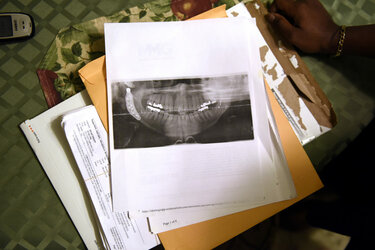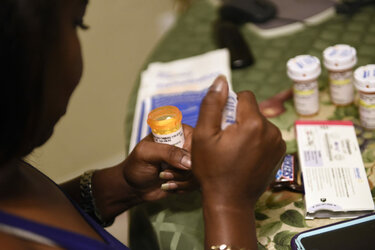Drug used to halt puberty in children may cause lasting health problems
By Christina Jewett — Kaiser Health News Feb. 2, 2017

Sharissa Derricott outside of her parents’ home in Lawton, Okla.NICK OXFORD FOR KHN
For years, Sharissa Derricott, 30, had no idea why her body seemed to be failing. At 21, a surgeon replaced her deteriorated jaw joint. She’s been diagnosed with degenerative disc disease and fibromyalgia, a chronic pain condition. Her teeth are shedding enamel and cracking.
None of it made sense to her until she discovered a community of women online who describe similar symptoms and have one thing in common: All had taken a drug called Lupron.
Thousands of parents chose to inject their daughters with the drug, which was approved to shut down puberty in young girls but also is commonly used off-label to help short kids grow taller.
The drug’s pediatric version comes with few warnings about long-term side effects. It is also used in adults to fight prostate cancer or relieve uterine pain and the Food and Drug Administration has warnings on the drug’s adult labels about a variety of side effects.
More than 10,000 adverse event reports filed with the FDA reflect the experiences of women who’ve taken Lupron. The reports describe everything from brittle bones to faulty joints.
In interviews and in online forums, women who took the drug as young girls or initiated a daughter’s treatment described harsh side effects that have been well-documented in adults.
Women who used Lupron a decade or more ago to delay puberty or grow taller described the short-term side effects listed on the pediatric label: pain at the injection site, mood swings, and headaches. Yet they also described conditions that usually affect people much later in life. A 20-year-old from South Carolina was diagnosed with osteopenia, a thinning of the bones, while a 25-year-old from Pennsylvania has osteoporosis and a cracked spine. A 26-year-old in Massachusetts needed a total hip replacement. A 25-year-old in Wisconsin, like Derricott, has chronic pain and degenerative disc disease.
“It just feels like I’m being punished for basically being experimented on when I was a child,” said Derricott, of Lawton, Okla. “I’d hate for a child to be put on Lupron, get to my age and go through the things I have been through.”
In the interviews with women who took Lupron to delay puberty or grow taller, most described depression and anxiety. Several recounted their struggles, or a daughter’s, with suicidal urges. One mother of a Lupron patient described seizures.
Such complaints have recently come under scrutiny at the FDA, which regulates drug safety.
“We are currently conducting a specific review of nervous system and psychiatric events in association with the use of GnRH agonists, [a class of drugs] including Lupron, in pediatric patients,” the FDA said in a statement in response to questions from Kaiser Health News and Reveal from the Center for Investigative Reporting.
The FDA is also reviewing deadly seizures stemming from the pediatric use of Lupron and other drugs in its class. While there are other drugs similar to Lupron, it is a market leader and thousands of women have joined Facebook
groups or internet
forums in recent years claiming that Lupron ruined their lives or left them crippled.
But the FDA has yet to issue additional warnings about pediatric use, and unapproved uses of the drugs persist.
Meanwhile, pediatricians and industry researchers are criticizing doctors for using Lupron to help kids with normally timed puberty grow taller, an “off-label” practice that was shown more than a decade ago to cause harm. Off-label prescribing is legal and common, but means doctors are using drugs in ways the FDA did not determine to be safe and effective.

A jaw X-ray from one of Derricott’s many surgeries sits on the table at her parents’ home.NICK OXFORD FOR KHN
In 2009, an international consortium of pediatricians had
warned against such use. Among them was a pediatric endocrinologist, Dr. Erica Eugster, whose research found that puberty-delaying drugs are widely used off label, even though the safety of such prescribing is unproven.
The health problems described by more than a dozen women in interviews could illustrate long-range effects of pediatric use and warrant further investigation.
“That’s what you have to ask, ‘Is this the tide rising?’” said Dr. Alan Rogol, a University of Virginia Medical School professor emeritus in pediatrics who said he prescribed the medication for decades. “None of us can answer that.”
AbbVie Inc., the company that now makes the drug, said Lupron safety studies were submitted to the FDA before it approved the medication for Central Precocious Puberty in 1993. The drug’s label defines the condition as the onset of sexual characteristics before age 8 in girls and before 9 in boys.
“Uses beyond those contained in the approved label are considered unapproved uses,” company spokesman Morry Smulevitz said in an email.
Federal records show that the FDA official who led the drug approval process two decades ago was troubled by the two studies he reviewed. In
a 1993 letter obtained under the Freedom of Information Act, former FDA medical officer Dr. Alexander Fleming wrote in a memo for the drug approval file that it was “regrettable” that the panel approved the drug after minimal study.
One study followed 22 children for just six months, Fleming said. He described the other study as a “free for all” review that made it difficult to determine what dose was best for children of different sizes. Still, he suggested long-term tracking of the drugs’ effects and favored approval “in the absence of any better approach.”
The study Fleming referred to as the “free for all” concluded in 1992, according to a summary submitted
to European authorities. Fleming had no further comment when contacted recently.
A different drugmaker-sponsored study, completed long after Fleming’s letter, looked at children who had taken Lupron for precocious puberty from 1991 to 2009. The
2010 study, which was submitted to the FDA, reported that seven of 55 kids had suffered serious side effects, but said the only serious side effects possibly related to Lupron were the growth of a preexisting tumor, deteriorating vision, and severe asthma exacerbation.
According to the National Institutes of Health repository of clinical research, which lists adverse effects discovered in studies, there are two serious
side effects of Lupron that aren’t mentioned in the drugmaker’s 2010 study: a bone disorder and a disease-caused fracture, an omission which looks “puzzling” to Dr. Ned Feder, a staff scientist at the Project on Government Oversight.
“It does seem to me that that is certainly a point of criticism,” Feder said. “What are they doing? Is this an accident?”

Derricott waits to renew her prescriptions to treat several conditions she says have plagued her since taking Lupron at a young age.NICK OXFORD FOR KHN
Smulevitz and the author, Dr. Peter A. Lee of the Penn State College of Medicine, did not answer specific questions about the report. The 2010 study Lee wrote was sponsored by Abbott Laboratories, and is not published in a peer-reviewed journal.
Abbott, which was once part of a joint venture that made Lupron, said in a statement that Lupron and the rest of its pharmaceutical business were transferred to AbbVie in 2013.
AbbVie paid the author, Dr. Lee, $157,066 from 2013 through 2015 for traveling and speaking about Lupron across the nation,
according to publicly available Medicare data. Lee did not respond to questions about his financial relationship with the drug company.
Smulevitz, the company spokesman, said AbbVie “regularly monitors and reports to [the] FDA (as well as other regulatory agencies) new safety information on an ongoing basis to ensure that our label contains accurate and up-to-date information to assist prescribers and patients.” He said prescribers are referred to other Lupron warning labels to review adverse events.
The FDA, in its statement, said it continues to review post-marketing reports of Lupron and other drugs in its class, monitors adverse-event reports, and informs the public of safety concerns.
If the FDA reaches any conclusions, Derricott would like to know. She says she took Lupron from age 5 to 12 to shut down early puberty. At 30, she’s among the first patients who took the drug — even before it was approved for pediatric use. She says now that she’s had more surgeries than her 79-year-old father, and suffers from a blood disorder and bone and joint problems.
“Excuse my language, but it’s hell,” she said.
Lupron’s history
When drugs like Lupron were discovered in the 1980s, it was like a miracle to pediatric endocrinologists like Rogol.
Lupron and drugs in its class were a solution to a rare but troubling problem: Toddler, preschool, and kindergarten-age girls were developing breasts and unexpected body hair. The drug works in the brain to shut down estrogen flow, essentially halting the body’s progress toward puberty. Once the injections cease, the process of puberty resumes.
Experts estimate that boys represent about 10 percent of the kids taking Lupron, many because of tumors or other conditions triggering early puberty.
In the years since the drug was first approved for children, Lupron usage has come under broad review.
Initially approved in 1989 to treat prostate cancer, Lupron works by cutting off the hormones that exacerbate conditions such as prostate cancer and excessive uterine growth. Its effect of chemically castrating men represented an advance over the option men faced previously — surgical castration. Obstetricians and urologists have relied on the drug for decades.
A nonprofit representing 90 percent of the nation’s fertility clinics says many doctors
use the drug off-label to prepare women for in-vitro fertilization. Yet, the Lupron label warns of birth defects in rodents and
advises against using the drug when one is considering pregnancy.
As with many drugs, side effects have long been a problem. More than 20,000 adverse-event reports have been filed with the FDA in the last decade. Women have reported to the FDA hundreds of cases of insomnia, depression, joint pain, and more than 100 cases of blurred vision. About 900 reports cite side effects that children below age 13 have suffered, mostly within months of taking Lupron. Those reports frequently note injection-site pain but also include dozens of cases of bone problems, such as pain or disorders, and the inability to walk.
Among men who take Lupron, its label warns of increased risk of heart attacks, strokes and sudden death. Drug labels are developed jointly by the FDA and the companies involved.
Related:
Adverse event reports are effective at flagging simple conditions that doctors recognize as an immediate consequence of taking a drug, such as vomiting or nausea. They are less prone to be filed and less effective at identifying longer-range problems, according
to critics of the FDA’s oversight of approved drugs.
“As a parent, I kick myself,” says Jeanne Walsh, a Temecula, Calif., resident who filed an adverse event report years ago, as did several other mothers interviewed recently for this story because their children took Lupron. Walsh’s daughter took Lupron for precocious puberty and now struggles with fibromyalgia and has had jaw-joint surgery. “What was I thinking?”
In 1999, the FDA examined 6,000 adverse-event reports about Lupron filed by doctors, patients, and researchers. Although the FDA couldn’t locate its 1999 report on the matter, a court document that summarized the findings of the report said it found “high prevalence rates for serious side effects” including depression, joint pain, and weakness, and noted similar effects in men and women with very different ailments suggested the drug was causing the problems rather than underlying medical conditions.
The FDA made no major change, but reviewed the drug labels to determine whether the side effects were covered.
The drug made headlines two years later. Justice Department
officials announced a civil and criminal settlement with Lupron’s then-maker. Prosecutors said the Lupron sales team rewarded doctors prescribing the drug for prostate cancer with ski trips, golf outings, and bribes. In a court document, one gynecologist said a salesperson told him he “could earn $100,000 annually” by treating the women in his practice with Lupron.
The settlement resulted in a corporate guilty plea for conspiracy to violate prescribing laws and one of the largest fines at the time — $875 million.

Derricott prepares her afternoon medication at her parents’ home. She’s been diagnosed with degenerative disc disease and fibromyalgia.NICK OXFORD FOR KHN
Lupron was back in the courtroom in 2008, when patient Karin Klein sued the drugmaker, which was previously TAP Pharmaceutical Products, Inc., a joint venture of Takeda Pharmaceutical Co. and Abbott Laboratories, after she took the drug as a teen to treat endometriosis. Klein alleged that she was not adequately warned of the drug’s effects and after taking the drug as a teen for a uterine condition, developed degenerative disc disease, jaw-joint dysfunction, and bone thinning, court records show.
According to a court record in her case, a report by Dr. John Gueriguian, a former FDA medical officer serving as an expert witness for Klein, said the drug causes “irreversible side effects and permanent severely disabling health problems.”
“When a drug’s risks outweigh the drug’s benefits, a drug should be banned and pulled from the market,” Gueriguian wrote. Reached recently, he said he had no further comment.
Attorneys for the drugmaker said Klein’s problems were not caused by the drug. Klein lost the case before a Las Vegas jury and was denied appeals up to the Supreme Court over what her attorneys argued were unfair limits on the expert reviews, scientific studies, and adverse-event reports that could be shown to jurors.
Lupron, which is marketed globally, has been a highly successful pharmaceutical product. Its current maker, AbbVie, reported 2015 Lupron sales of $826 million.
Perils of off-label use
Brooklyn Harbin said she received Lupron after she started her menstrual cycle at age 10. The chance to slow her puberty had passed but she hoped to add a few inches to her 4-foot 9-inch frame before her body matured any further.
According to medical research, doctors prescribe the puberty blocking drug to short kids to essentially give them more time to get taller, since puberty culminates with the body’s long bone growth ending.
Medical researchers have repeatedly warned against such off-label usage. A 2003
study in the New England Journal of Medicine concluded that some kids on drugs like Lupron developed osteopenia and lost too much bone density during a three-year course of treatment to justify the therapy. In other words, the lifetime risk of breaking a bone outweighed the reward of growing a bit taller.
Still, Harbin said she began getting shots of Lupron in 2006. Soon afterward, she said her physical problems began.
At 10, after her 10th shot of Lupron, she said she collapsed during a Wal-Mart shopping trip with family. She could feel nothing from the knee down. Harbin said she spent six months in a wheelchair before she regained her strength and could walk again. She had to give up cheerleading, basketball, gymnastics and karate because of her low bone density.
By seventh grade, she said she spent a month at the Mayo Clinic in Minnesota learning to cope with chronic pain.
FDA records obtained via a public records request show that her pediatric specialist reported that a pharmacy erroneously gave her grandmother an extended-release, 3-month formula of the medication, instead of a monthly dose at the same strength. It remains unclear whether the dosing error impacted her health.
Harbin said she was diagnosed at 11 with osteopenia, a thinning of the bones milder than osteoporosis. Although her bone density returned to a normal range at 16, her chronic pain has forced her to reconcile her dreams with her physical limitations.
“I felt like little pieces of my life were just taken away from me and no one wanted to own up to it,” said Harbin, who is now 20 and lives in South Carolina. “Suicide became very, very real for me.”
“As a parent, I kick myself… What was I thinking?”
JEANNE WALSH, WHOSE DAUGHTER TOOK LUPRON
Eugster, director of pediatric endocrinology at the Indiana University School of Medicine, has written that far too many doctors confronted with parents’ concerns about a short child reaching puberty too soon are inclined
to “do something,” even though the safety of off-label prescribing “can’t be inferred to exist.”
And the puberty-delaying drugs are expensive — $20,000 to $40,000 for two years of treatment, Eugster reported in The Journal of Pediatrics in 2015.
In another 2015 study, Eugster reviewed the records for 260 kids prescribed Lupron or a similar drug and concluded that 27 percent of them didn’t meet the definition of Central Precocious Puberty. More than half who were treated off-label were prescribed the drug in the hope of increasing their height, according
to the report in the journal Endocrine Practice.
Another group of researchers also urged restraint in prescribing drugs to children to improve height in a 2011
article in The Journal of Pediatrics. Led by a pediatric radiology researcher, the research physicians found that even minor delays in puberty reduce children’s bone density, “stressing the need for caution in the use of treatments aimed at prolonging the growth period.”
The FDA
approval documents for pediatric Lupron say Central Precocious Puberty affects an estimated 2,000 US children each year, something considered an “orphan disease” because of its rarity. Yet doctors wrote 24,000 prescriptions for the medication in 2015, at an average cost of $8,300 for a 3-month long-acting prescription of the drug, according to IMS Health, a medical research firm.
Twice as many prescriptions were written for the drug in 2011, according to IMS Health, though that was before the long-acting dose was used more routinely.
Living with long-term problems
Valerie Ward, 25, who lives outside of Pittsburgh, said she took Lupron for precocious puberty from age 9 to 12. Like Derricott, Ward said she sees a carousel of medical specialists for excruciating muscle and bone pain, depression, weakness, and fatigue.
The symptoms mystify each woman’s doctors. Yet they sound all too familiar to Chandler Marrs, a researcher who has studied Lupron’s side effects in adult women under treatment for uterine disorders.
Marrs, an endocrine specialist who studies women’s health, said she was surprised by the severity and duration of Lupron’s side effects, so she posted a survey aimed at getting more information. With little funding to do outreach, more than 1,000 surveys came back.
The
women reported a wide range of symptoms: 30 percent cited severe joint pain, 29 percent, severe body aches; 26 percent, cracking teeth; and 20 percent reported osteoporosis. More than half reported moderate to life-threatening depression. Fifteen percent of the women rated their suicidal thoughts as life-threatening to severe.
Marrs believes a uniting factor explains the diverse and severe range of symptoms. Lupron cuts off a woman’s estrogen, eliminating a key hormone called estradiol that regulates the energy centers of the cell, the mitochondria. She said the missed connection between the hormone and cellular powerhouse will hurt each woman where her body is most vulnerable.
“If your mitochondria break down, your nerves start to break down; if your nerves start to break down, your muscles break down. It’s the cascade of effects,” said Marrs, chief executive of the Nevada-based Lucine Health Sciences research firm.
At 20, Ward says she felt like her health was failing. She had muscle weakness so severe that she could barely lift her arms to wash her hair. Debilitating pain coursed through her body. Doctors puzzled over her blood disorder. She’s been hospitalized after feeling suicidal and depressed.
Last year, at 25, she suffered a seizure that resulted in a cracked vertebra.
“It was the most intense pain I felt in my entire life,” Ward said.
Then came another diagnosis: osteoporosis.
The condition would come as little surprise to anyone familiar with Lupron’s use in adults. Adult women using the drug to induce menopause after uterine disorders
are warned on the drug’s adult label not to take an initial course longer than six months to avoid serious bone density loss. They are also encouraged to take hormonal “add-back” drugs to soften the side effects.
A Journal of Clinical Oncology
study published in 2005 of men who take Lupron for prostate cancer found that it “significantly increased” the risk of fractures, with prolonged use raising the risk. Yet the impact on kids’ bones is still up for debate.
Related:
In interviews, several pediatric endocrinologists pointed to studies showing that kids’ bones do thin while they’re on Lupron, but then they bounce back to normal. One 2009 study by Italian researchers examining 66 girls
found that bone density was significantly lower after treatment, but within about 10 years, returned to a level comparable to women who served as study controls. A German
study concluded there was no harm to bones, even though seven of 41 women studied, or 17 percent, had osteopenia several years after their treatment ended, according to the Journal of Clinical Endocrinology & Metabolism.
Other studies published in international medical journals reached different conclusions. Researchers in Taiwan found “a possible major side effect” when they
studied 11 girls who started Lupron at around age 8 and continued treatment for about 5 years. When the women were about 20, they performed bone scans and found that 45 percent of the women had lower-than-average bone density and merited a diagnosis of osteopenia.
Another study by researchers in Turkey concluded that treatment with Lupron for precocious puberty “may have adverse effect on bone health” due to severe vitamin D deficiencies.
Their study, published by the West Indian Medical Journal, found that 13 children on Lupron for precocious puberty had serious vitamin shortcomings, compared to two children in a control group.
Canadian researchers
also identified five children who developed the same bone problem within years of taking a puberty-delaying drug, according to a 2013 study in Hormone Research in Paediatrics, a medical journal. The children each suffered from slippage in the long bone of the leg, near the hip, due to “a lack of adequate sex hormone exposure at a ‘critical period’ of bone formation.”
The FDA considers the drug’s impact on children’s bones an unanswered question, according to a statement: “The effects of bone density in children whose central precocious puberty is arrested with a GnRH agonist are considered ‘unknown’ as they have not been studied.”
By and large, though, the US doctors who dispense Lupron to children are not in a position to see problems that may emerge a decade later, said E. Kirk Neely, a Stanford professor and pediatric endocrinologist. He noted that studies done in Europe haven’t identified long-term joint dysfunction or depression as problems.
“I’m concerned. There’s a very fundamental problem. We treat these kids, they disappear, and we never see them again,” Neely said. “We don’t have good follow up, particularly in the US.”
Whether Lupron is causing the women’s’ long-term problems, “the answer is I don’t know.”
This story was originally published by Kaiser Health News and Reveal from the Center for Investigative Reporting.
About the AuthorReprints
Christina Jewett — Kaiser Health News
@by_cjewett










